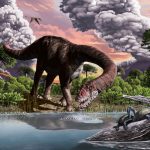Archaeologists find vast network of Amazon villages laid out like the cosmos0
- Ancient Archeology, From Around the Web
- December 9, 2020
Laser and satellite technology revealed more than 35 villages.

Laser and satellite technology revealed more than 35 villages.

Unpublished notes show he believed ancient structures held key to the apocalypse

Paleontologists in Argentina have identified a new species of eusauropod (true sauropod) dinosaur that lived 179 million years ago, just after the mysterious disappearance of non-eusauropod sauropodomorphs.

The idea that modern humans displaced Neanderthals because they were better protected against toxins from smoke is now under fire. An earlier study that put forward this suggestion has now been refuted by genetic research by scientists from Leiden and Wageningen. This new research was published in Molecular Biology and Evolution on 24 November.

Thanks to a bit of help from a particle accelerator, scientists have discovered an unusual amulet interred with a 2000-year-old mummy.

As ancient remains are uncovered and dated, archeologists expand their search for the evolutionary birthplace of Homo sapiens, and debate whether such a place exists.

Volcanic activity may have altered plant life and ushered in rise of dinosaur giants

What baffles modern viewers about the Nazca Lines is their scale. These sprawling geoglyphs are so large that they are difficult to perceive from the ground. Their incomprehensible dimensions have led some to peddle racist conspiracy theories that they were created by aliens (as if it were easier to believe in aliens than to attribute these feats to Indigenous American societies). The key to understanding one recently rediscovered geoglyph, however, lies in much smaller works of art.

The final chapter of dinosaur history is a tale stretching across two very different worlds, each a vast supercontinent dominated by its own unique mix of predators and herbivores.

When and how did the first animals appear? Science has long sought an answer to this question. Uppsala University researchers and colleagues in Denmark have now jointly found, in Greenland, embryo-like microfossils up to 570 million years old, revealing that organisms of this type were dispersed throughout the world. The study is published in Communications Biology.



